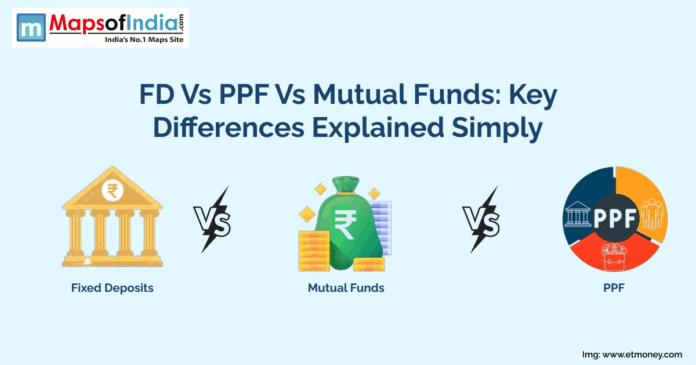Proper money management and investing your financial assets properly are important to achieve financial stability. Investing can feel overwhelming at the beginning. Financial terms like FD, PPF, and mutual funds pop up everywhere and feel out of the syllabus. Each option serves different goals. Fixed Deposits (FDs), Public Provident Fund (PPF), and mutual funds are the most used terms in the financial world. This terminology is important for various needs, from safety to growth. But understanding these can shape your financial future.
What Are Fixed Deposits (FDs)?
FDs or fixed deposits are bank savings schemes. You deposit a particular lump sum of money for a fixed period. Banks pay you interest on that amount. The deposition term ranges from 7 days to 10 years. Interest rates vary, nowadays, it’s 5 to 8%. In the State Bank of India, FD offers 7% for a 5-year term, according to an Economic Times report. Your money is locked in the bank till your FD reaches maturity. Early withdrawal can result in penalties. FDs are a safe option backed by banks. They suit investors who don’t want to take risks. Investors know exactly how much they will earn. Senior citizens often get higher rates. It’s a simple way to grow savings steadily.
What Is a Public Provident Fund (PPF)?
PPF or public provident fund is a savings scheme backed by the government. This scheme is designed for long-term wealth building. Under this scheme, you deposit money annually, up to ₹1.5 lakh. The term of this scheme is 15 years, extendable by 5-year blocks. Nowadays, PPF offers 7.1% interest. Interest under this scheme is compounded yearly. Deposits qualify for tax deductions under Section 80C. Returns are tax free. Opening PPF account is simple. You can open a PPF account at banks or post offices. Some amount of monetary withdrawals is allowed after 7 years. This scheme is ideal for retirement planning. PPF is ultra safe scheme, with guaranteed returns. It’s perfect for cautious investors seeking stability and planning life after retirement.
What Are Mutual Funds?
Mutual funds gather money from investors. Fund managers invest that money in stocks, bonds, or other assets. They aim for growth or income. Returns in mutual funds aren’t fixed, unlike FDs or PPFs. Equity funds focus on stocks, which offer high growth potential. While debt funds invest in bonds, which prioritise safety. Hybrid funds mix both. According to a Business Standard report, investors receive 8 to 12% average returns for equity funds over 5 years. You can start with ₹500 via SIPs (Systematic Investment Plans). Mutual funds have market risks. If investors want higher returns over time, mutual funds are for you.
Risk Levels Compared
Risk in each scheme is different and is a key differentiator. FDs are a low risk investment. Banks take a guarantee of your principal and interest. Deposit Insurance covers up to ₹5 lakh per depositor. Public Provident Fund PPF is an even safer option. This scheme is backed by the government. Your money is secure, and you will receive fixed returns. Mutual funds vary widely. Equity funds are high risk investments due to market swings. According to a recent Financial Express report, a 20% drop in equity funds is noted during market crashes. Debt funds are safer but not risk-free. Hybrid funds balance risk. Choose FDs or PPF if you are looking for safety. Pick mutual funds for growth, if you can handle risk.
Returns and Growth Potential
FDs will give you predictable and fixed returns. Return rates range from 5 to 8%. Which are fixed from the start. A 5 year FD, which has 7% growth rate, grows from ₹1 lakh to ₹1.4 lakh. PPF will give you steady returns at 7.1%. In 15 years, ₹1.5 lakh will become ₹3.25 lakh. Mutual funds can give you more returns. Equity funds averaged 10 to 15% over a decade. But returns are not guaranteed in a mutual fund. A ₹1 lakh SIP could grow to ₹2 lakh or drop, which all depends on the bad market. FDs and PPF suits if you want a return without taking risks. Mutual funds will offer higher rewards, but they come with market risk.
Tax Benefits and Implications
Tax rules can also influence your investment choice. If you invest in FDs, no tax will be deducted. Interest is taxable as income. Banks will deduct TDS if interest exceeds ₹40,000 each year. PPF is a tax friendly investment. Deposits up to ₹1.5 lakh qualify for Section 80C deductions. Interest and withdrawals are tax-free in PPF. Mutual funds vary according to the market. If you invest above ₹1.25 lakh in Equity funds, you may gain 12.5% long-term capital gains tax. Debt fund gains are taxed as income. ELSS mutual funds offer 80C deductions. Forbes India suggests PPF for tax savings. Planning investments can help you save taxes. Consult a tax advisor for clarity.
Ease of Investment for Beginners
Investing your money in FDs is beginner-friendly. For FD, you need to visit a bank or use net banking. Follow the simple steps: Fill out a form, deposit money, and get a receipt. PPF is also simple. The investor just needs to open an account at a bank or post office. Deposit via cash, cheque, or online. Investing in Mutual funds requires more effort. You choose funds based on your financial goal. Online platforms like Groww or Zerodha help in investing. This app makes investment easy. Beginners in mutual funds can start with SIPs as low as ₹500. To invest in Mutual funds, you require market knowledge. FDs and PPF need minimal research. Pick what matches your comfort level and your financial goal.
Why Understanding These Matters
Understanding where you want to invest is an important step to get into this. Choosing between FDs, PPF, and mutual funds will shape your financial future. FDs guarantee safety but give low growth. But there is a tax. PPF balances tax benefits and gives investors steady returns. Mutual funds give high returns with high risk. According to the Business Today report India’s rising investor base is noted. Over 10 crore people have invested in mutual funds. FDs are still a popular option among investors with ₹1.5 lakh crore in deposits. PPF accounts are also growing. Each option looks into different needs. If you want to get into investment, you should start small and learn. Mixing all three with proper financial knowledge creates a balanced portfolio. Proper financial knowledge empowers you to build wealth confidently.





